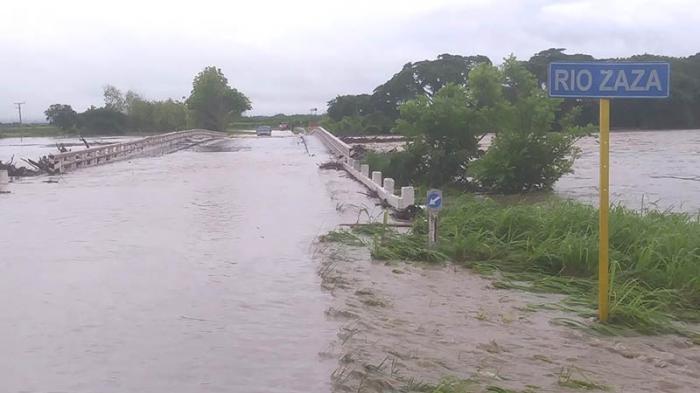
Over recent days the western and central regions of the country have been affected by heavy rain caused by subtropical storm Alberto, which is beginning to weaken over the Gulf of Mexico and southern coast of the United States.
The rains have severely impacted segments of the National Highway and railway transport in some areas.
Heavy rain in Villa Clara has caused damage to homes - 64 total collapses and 138 partial - as well as to agriculture. Highways have been closed; over 16,000 people evacuated; and various areas within the province’s 13 municipalities cut-off.
According to information from Provincial and Municipal Defense Councils, one of the worst affected zones is El Santo, where the River Sagua la Chica has crested, flooding homes and institutions in the community.
The same situation is affecting the mountainous area of Manicaragua, currently cut-off from the rest of the province after swelling rivers interrupted access to Jibacoa and other communities in the zone.
In Sagua la Grande, the floodgates of the Alacranes reservoir, as well the 11 others in the province, have been opened after the former reached 133% of its capacity, after accumulating 400 million cubic meters of water. For the moment the neighborhoods of La Gloria, La Rosita, and Viana are all cut off in Villa del Undoso, due to flooding.
Significant damage to agriculture, especially corn, cassava, and sweet potato crops has been reported in Cifuentes, while work is underway to protect the tobacco harvest in Manicaragua, Camajuaní, and other zones.
All schools in Villa Clara have been closed until the situation returns to normal, while boarding students have been sent home, according to information from Provincial Defense Council Vice President, Alberto López Díaz.
THE ZAZA REACHES ITS LIMIT
Although its floodgates have remained open since May 26, the Zaza reservoir, the country’s largest, reached maximum capacity – 1,020 cubic meters - at around midday on May 28, with water levels continuing to rise in a clear demonstration of the impact of rainfall, caused by sub-tropical storm Alberto on this part of the island.
Sources from the National Water Resources Institute provincial office confirmed that spillways and flood gates are being activated in order to alleviate the situation, while over 8,800 people from several municipalities whose homes have been flooded have been evacuated to different centers or are staying with relatives.
Likewise, heavy rainfall and landslides have resulted in the closure of various points along the National Highway, as well as the north and south-bound routes connecting the municipality of Yaguajay to the provincial capital and the community of FNTA in Trinidad, where the Agabama River has caused severe flooding.
Residents from the community of Zaza del Medio confirmed via telephone that the bridge over the River Zaza, which connects this locality to the provincial capital, was swept away on May 28.
SUPPORT TO EVACUEES IN MATANZAS
More than 6,000 residents in zones at risk of flooding have been evacuated in the province of Matanzas, following intense rainfall over the region.
Mario Sabines Lorenzo, vice president of the Provincial Assembly of People’s Power explained that by May 28, the majority of those that have been evacuated are from the neighborhoods of Itabo and El Zapato, in the municipality of Martí, an area prone to flooding.
He also noted that around 900 people were relocated to safer areas in Pedro Betancourt, as well as residents living in the high risk zones of Perico, Ciénaga de Zapata, and Colón.
According to Sabines Lorenzo, all evacuees placed in state shelters (21) are being provided with everything they need, including food, medical services, and the protection of their belongings.
Arturo Carbonel, representative of the Institute of Water Resources, reported that reservoirs in the province have reached 72% of their general capacity, and that half are releasing water.
The most complicated situation, he noted, is in the communities north of the municipality of Martí (El Zapato, Hoyo Colorado, Este de Itabo and Ategorrieta), affected by flooding of the La Palma River and waters from the Bibanasí reservoir.
Meanwhile Lourdes Sarmiento Díaz, vice president of the Matanzas Administration Council, explained that heavy rainfall has also caused damage to homes, facilities, and power supplies in the area.















